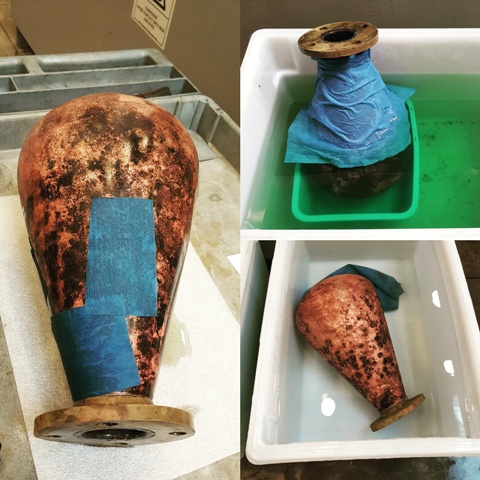In addition to the “tank-farm-team-effort” that has been going on here for almost three months, a lot of work has been done around the lab. On Mondays and Fridays, tanks are either draining or filling which gives us all the opportunity to carry on other treatments.
For instance, a few weeks ago Laurie and I cleaned the starboard carriage tank. Microorganism growth had been developing over the summer due to the increased heat and light and it was time to give it a little TLC.

Lesley and I later cleaned another large tank in the wet lab containing a ventilation engine. Maintenance requires not only scrubbing the tanks, but also changing reference electrodes, making sure the multimeters and pH probes are working properly and preparing new solutions. This involves lifting 50lbs sodium hydroxide bags. Yes we can!
Recently we were also all very pleased with the treatment outcome of an air flask from the starboard Worthington pump. Images speak for themselves:


Lesley has been working on rubber gaskets from the same pump and Kate is in charge of completing the treatments of other copper alloy components. The main cast and wrought iron parts of the pump have been treated by several conservators in the past, including Will. Things are coming along and soon enough the complete starboard Worthington pump will be fully conserved and stable! This year has been particularly exciting regarding the USS Monitor’s Worthington pumps as the American Society for Mechanical Engineering (ASME), the world’s premier metals engineering professional society, designated them as a Historic Mechanical Engineering Landmark! Check out the great story the Daily Press published about it.
This week Tina is at a VOSH (Virginia Occupational Health and Safety) conference to learn more about keeping us safe from ourselves around the lab. And next week, I’ll have the chance to attend a two day symposium at the Smithsonian on “The Mechanics of Art Materials and its Future in Heritage Science”. Courses will discuss current and future trends in the study and preservation of cultural heritage, including material mechanics research. Collections monitoring as well as new protocols for storage environments will also be discussed. I am looking forward to soaking in every bit of new information on these topics!
Oh, yes, and I almost forgot… as of yesterday, we are DONE working in the tank farm for the year! We completed the mechanical cleaning of 6.2 US tons of material with dry ice. Meaning 6.2 tons of material was moved, piece by piece with a gantry crane and/or a forklift out of its tank, blasted with dry ice and then moved back into its tank. It was nasty, smelly, hot and highly physical work but we are all very pleased with the results. Electrolytic reduction is back on in all tanks and our “salt nemesis” should be removed much more easily now that the objects’ surfaces are cleaned. Cheers to that!
Wishing you all a great weekend!